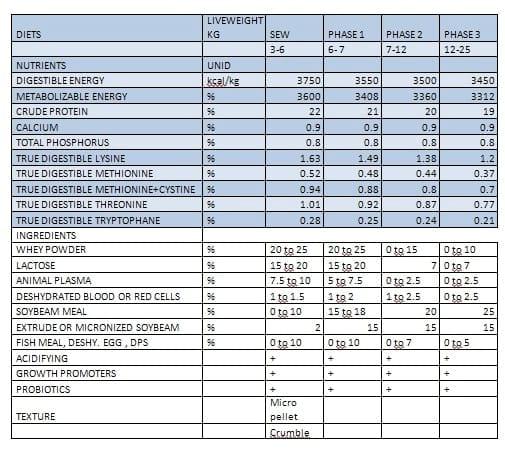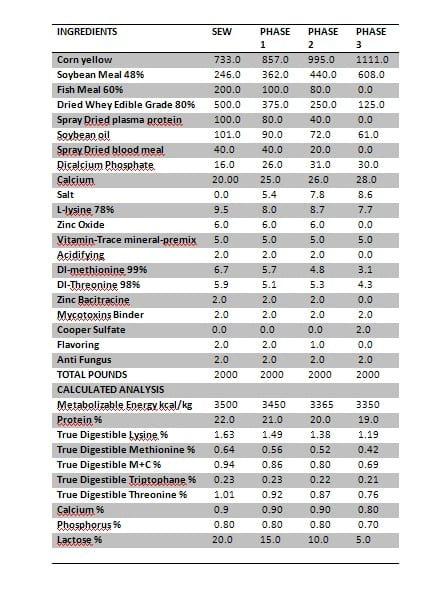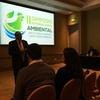Early Weaned Pig
Published: October 12, 2010
By: Joaquin Paulino (NTECRD)
INTRODUCTION
The swine industry has largely gone to early weaning (3 weeks or earlier) especially in confinement production systems with environmentally controlled nurseries. Economic factors such as increasing the number of pig per sow per year and the need to maximize the capital cost of swine farrowing units by moving more sow through the facilities has resulted in this change.
Two essential factors for early weaning are:
1-Utilization of complex high nutrient, high density prestarter diets.
2- Well designed, environmentally controlled nurseries.
PHASED FEEDING
Nutritional requirements for early weaned pig change rapidly during the early post weaning period. A phased feeding program is essential to minimize the post weaning lag problem and to get pigs started on grain-soybean meal diet as quickly as possible. Complex diets as described in table 3 and 4 are need to achieve maximum feed intake and gain during the post weaning period.
The goal of the nutritional program remains the same regardless of the number of diet phases used. That goal is to transition pigs to a low-cost, grain-soybean meal -based diets as quickly as possible after weaning without sacrificing growth performance. In most cases, pigs achieve this goal without higher-cost products such as whey, plasma protein or fish meal.
A four phase feeding approach replaced the traditional, three-phase system in the nursery phase when younger weaning ages were implemented in multi-site pig production.
With later weaning, many producers are reevaluating feed budgets or reverting back to the three-phase (See table 1 and 2).
The concept of matching the digestive capacity of the pig to the ingredient s use in the rations should not charge.
The swine industry has largely gone to early weaning (3 weeks or earlier) especially in confinement production systems with environmentally controlled nurseries. Economic factors such as increasing the number of pig per sow per year and the need to maximize the capital cost of swine farrowing units by moving more sow through the facilities has resulted in this change.
Two essential factors for early weaning are:
1-Utilization of complex high nutrient, high density prestarter diets.
2- Well designed, environmentally controlled nurseries.
PHASED FEEDING
Nutritional requirements for early weaned pig change rapidly during the early post weaning period. A phased feeding program is essential to minimize the post weaning lag problem and to get pigs started on grain-soybean meal diet as quickly as possible. Complex diets as described in table 3 and 4 are need to achieve maximum feed intake and gain during the post weaning period.
The goal of the nutritional program remains the same regardless of the number of diet phases used. That goal is to transition pigs to a low-cost, grain-soybean meal -based diets as quickly as possible after weaning without sacrificing growth performance. In most cases, pigs achieve this goal without higher-cost products such as whey, plasma protein or fish meal.
A four phase feeding approach replaced the traditional, three-phase system in the nursery phase when younger weaning ages were implemented in multi-site pig production.
With later weaning, many producers are reevaluating feed budgets or reverting back to the three-phase (See table 1 and 2).
The concept of matching the digestive capacity of the pig to the ingredient s use in the rations should not charge.
TABLE 1.FEED ALLOWANCES /PIG (WEANING TO 50 LB.)FOR A FOUR -PHASE FEEDING PROGRAM.


*SEW = Segregated Early Weaning or MEW=Medicated Early Weaning
TABLE 2. FEED ALLOWANCES /PIG (WEANING TO 50 LB.) FOR A THREE- PHASE FEEDING PROGRAM

Post weaning nutrition and feed budget: As weaning age increases, two different.
Approaches can used for diets fed immediately after weaning.
A producer may provide 0.5 or 1 lb. of a sew diet/pig and 1 to 3 lb. of a phase 1.
Nutrition and feed budget until 25 lb. this diets are typically a grain- soybean meal-based diet with 10 to 20 % of high quality source of lactose and a small amount of specially protein source, such as spray-dried blood meal, plasma protein or high quality fish meal.
Other speciality protein sources may be used, depending on economic considerations or location for example potato protein, extruder or micronized soybean meal, dehydrated egg and hydrolysates (DPS).
Growth promoting antibiotics, acidifying, artificial flavoring, probiotics and zinc oxide are typically used in this diets. Research indicates that 2000 ppm zinc is the optimal inclusion level.
TABLE 3.RECOMMENDED FEED SPECIFICATIONS FOR GENETIPORC PIGLET IN HOT CLIMATE


Nutrition and feed budget from 12 to 25 kg: this diet should resemble a grow- finish diet, which in most cases will be a simple grain-soybean meal diet without any specialty protein products or lactose sources. The digestive capacity of the at this weight is such that these ingredients are unwarranted; including them will increase feed cost /pig.
TABLE 4. EXAMPLE OF DIET IN DIFFERENT PHASES

RESUME

RESUME
When designing diets for piglets must be careful in using highly digestible ingredients such as whey, animal plasma, blood meal, and fish meal with minimum allergic effects in piglets, levels of soybean meal should be appropriate, it contains anti-nutritional factors such as glycinin an beta- conglycinin causing nutritional diarrhea, flavors, acidifying, probiotics, growth promoters and Zinc oxide should be added to these diets. Others ingredients may be used if cost permits for example: Dried egg protein, potato protein, and hydrolysates (DPS).
BIBLIOGRAPHY
BIBLIOGRAPHY
1-Dr. Loannis Mavromichalis, 2009. Ariston Nutrition, Madrid Spain, Pig Progress Vol 25.
2-William G. Luce and Charles V. Maxwell , 2007. Extension Swine Specialist, Oklahoma State University.
3-Joel DeRouchey; Mike Tokach; Steve Dritz; Bod Goodband; and Jim Nielssen, Kansas State university, 2005. Feeding Strategies for Weaned Pigs.
4-Dr. Gilbert Hollis, Illinois University, 2003. Manager and nutrition of Swine, Dominican Republic Conference.
2-William G. Luce and Charles V. Maxwell , 2007. Extension Swine Specialist, Oklahoma State University.
3-Joel DeRouchey; Mike Tokach; Steve Dritz; Bod Goodband; and Jim Nielssen, Kansas State university, 2005. Feeding Strategies for Weaned Pigs.
4-Dr. Gilbert Hollis, Illinois University, 2003. Manager and nutrition of Swine, Dominican Republic Conference.
Related topics
Authors:
Join to be able to comment.
Once you join Engormix, you will be able to participate in all content and forums.
* Required information
Would you like to discuss another topic? Create a new post to engage with experts in the community.
Create a postInsta-Pro International
5 de febrero de 2017
Thank you for this useful information. I assume the extruded soy recommendations are for full-fat? Extruded, partially deoiled soy meals, when processed properly, can replace solvent soybean meals in these formulations. Care must be taken to extrude the beans at the correct temperate, especially for these sensitive piglets.







.jpg&w=3840&q=75)